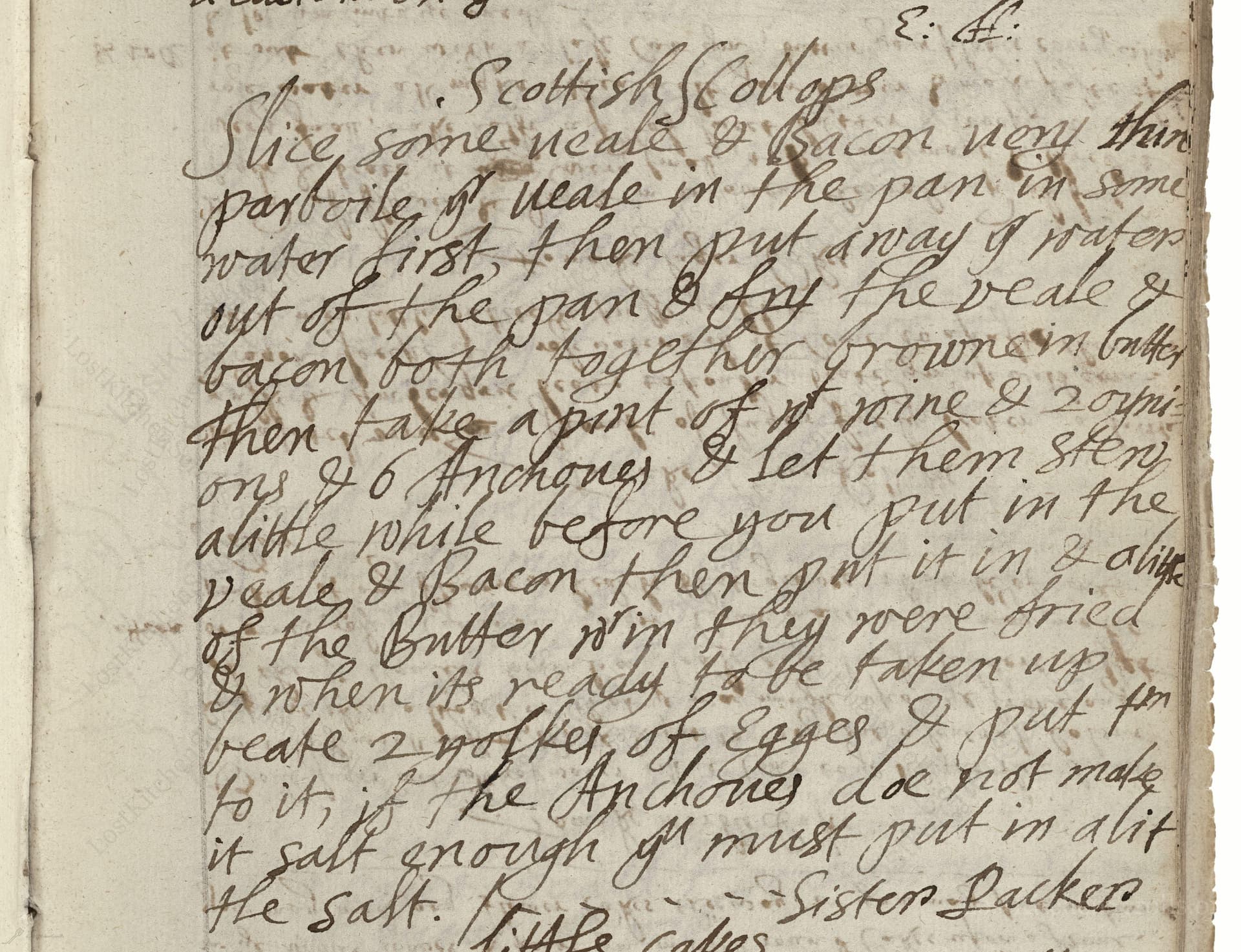Scottish Collops
From the treasured pages of Cookbook of L. Cromwell
Written by L. Cromwell

Scottish Collops
"Slice some veale & Bacon very thin parboile ye veale in the pan in some water first then put away ye water out of the pan & fry the veale & bacon both together browne in butterr then take a pint of wine & 2 oynions & 6 Anchoves & let them stew a litle while before you put in the veale & Bacon then put it in & a litle of the Butter w'rin they were fried & when its ready to be taken up beate 2 yolkes of Egges & put to it, if the Anchoves doe not make it salt enough yu must put in a litle salt."
Note on the Original Text
The recipe, like many from the 1600s, is written as a flow of instructions, with minimal punctuation and no ingredient list or precise timings. Spelling is eccentric—'oynions' for onions, 'yu' for you, 'Egges' for eggs, and so on—reflecting the variable English orthography of the period. Measurements are given in everyday terms (a 'pint' of wine, 'some' veal), so amounts must be inferred from context. This style trusts the cook’s experience and intuition rather than providing the step-by-step precision familiar to modern readers.

Title
Cookbook of L. Cromwell (1650)
You can also click the book image above to peruse the original tome
Writer
L. Cromwell
Era
1650
Publisher
Unknown
Background
Step back into the sumptuous kitchens of the 17th century, where L. Cromwell’s collection stirs up a medley of grand flavors and old English culinary traditions—a true feast for culinary historians and curious cooks alike.
Kindly made available by
Folger Shakespeare Library
This recipe for Scottish Collops comes from the 17th-century English manuscript 'V.a.8', compiled by Lady Cromwell in the 1600s. Collops—a term used historically for slices of meat—were a staple in both Scottish and English country kitchens. Such dishes were often served for breakfast or supper. The use of veal, bacon, anchovies, and wine is typical of the period’s love for rich, savory flavors, with anchovies acting as a natural seasoning in an era before modern stock cubes or Worcestershire sauce. The handwritten household manuscript reflects both everyday provision and noble tastes, offering a glimpse into the culinary world of early modern Britain.

Back in the 17th century, this dish would have been made over an open hearth or on a cast iron range. The cook would have used a heavy iron frying pan or skillet for both parboiling and frying the meats. A ladle or large spoon helped transfer hot food, and a sharp kitchen knife was essential for slicing veal and bacon. Eggs would be beaten by hand in a wooden bowl, and onions sliced using a simple kitchen knife. A lidded pan or small cauldron would be used for stewing the wine, onions, and anchovies.
Prep Time
15 mins
Cook Time
35 mins
Servings
4
We've done our best to adapt this historical recipe for modern kitchens, but some details may still need refinement. We warmly welcome feedback from fellow cooks and culinary historians — your insights support the entire community!
Ingredients
- 14 oz veal, sliced thinly (or use pork or chicken if unavailable)
- 3.5 oz streaky bacon, sliced thinly
- 2 cups dry white wine
- 2 medium onions, thinly sliced
- 6 anchovy fillets (about 1 oz), chopped
- 2 large egg yolks
- 2 tablespoons unsalted butter (for frying)
- Fine sea salt, to taste (if needed)
Instructions
- To prepare Scottish Collops in a modern kitchen, start by slicing about 14 oz of veal and 3.5 oz of streaky bacon thinly.
- Parboil the veal briefly in a frying pan with enough water to just cover it, until slightly cooked but not fully done.
- Discard the water, then add a knob of butter (about 2 tablespoons) to the pan, and fry both veal and bacon together until browned.
- Separately, in a saucepan, combine 2 cups of dry white wine with two thinly sliced onions and six chopped anchovy fillets.
- Let this mixture simmer gently for a few minutes to infuse the flavors, then return the browned veal and bacon to the pan with the wine mixture.
- Add a little of the frying butter as well.
- Let everything cook together for a few more minutes until flavors meld and the sauce reduces slightly.
- Just before serving, beat two egg yolks and stir them into the hot (but not boiling) pan to thicken the sauce—be careful not to scramble the eggs.
- Taste; if the anchovies have not provided enough saltiness, season lightly with salt.
Estimated Calories
430 per serving
Cooking Estimates
You will need about 15 minutes to prepare the ingredients and 35 minutes to cook the dish. Each serving has around 430 calories. This recipe serves 4 people.
As noted above, we have made our best effort to translate and adapt this historical recipe for modern kitchens, taking into account ingredients nowadays, cooking techniques, measurements, and so on. However, historical recipes often contain assumptions that require interpretation.
We'd love for anyone to help improve these adaptations. Community contributions are highly welcome. If you have suggestions, corrections, or cooking tips based on your experience with this recipe, please share them below.
Join the Discussion
Rate This Recipe
Dietary Preference
Main Ingredients
Occasions

Den Bockfisch In Einer Fleisch Suppen Zu Kochen
This recipe hails from a German manuscript cookbook compiled in 1696, a time whe...

Die Grieß Nudlen Zumachen
This recipe comes from a rather mysterious manuscript cookbook, penned anonymous...

Ein Boudain
This recipe comes from an anonymous German-language manuscript cookbook from 169...

Ein Gesaltzen Citroni
This recipe, dating from 1696, comes from an extensive anonymous German cookbook...
Browse our complete collection of time-honored recipes



